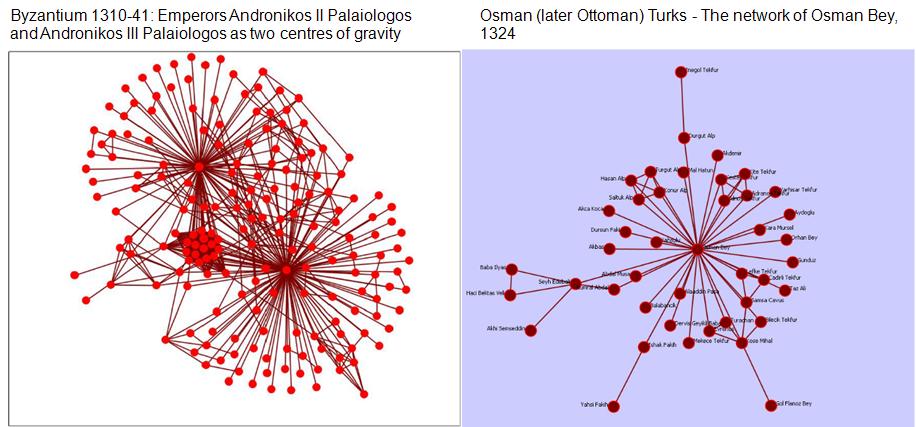We have been spending quite a lot of time looking at organisational structures, and what works and what doesn’t – and a rather fascinating analysis of the social networks of the later Byzantine and emergent Ottoman Turk leaders came up. The diagram above shows the 2 networks at a turning point, the period c 1310-40 when an already weakneed Byzantium erupted in civil war (hence the bi-modal Byzantine structure) and the Turks took advantage of this. We look a lot at the past for lessons, as the “what next” is known, so it is to some extent predictive.
The network analysis is blogged in more detail on my Broadstuff blog but the upshot is that while it’s easy to jump to the idea that a small, nimble, flexible structure ran rings around the ossified Empire, and victory was thus certain, this is simplistic for 3 main reasons:
Firstly, Byzantium at this time was a bigger, far more complex state than Osman’s Turkish statelet so needed more people to run it and – very unusually for it – was running with 2 co-Emperors (older one + nephew) and broke into a ruinous civil war in 1328 (half way through the analysis’s timespan) so the network would be massively bi-modal, with 2 opposing camps, by definition.
Secondly, the Byzantine system had been relatively stable for 800 years (just how they managed that that would really be worth studying) and had just re-unified after being broken up by the 4th Crusade so was still weak. Byzantium had seen the likes of Osman (and far worse) come and go many times over the centuries, so its not a slam dunk that Osman’s system was “better”. Arguably he got lucky, being around just at the time the weakened Empire was busy tearing itself apart (and Andronikus II was by all acounts one of the crappest Emperors they ever had), and other challengers – the Venetians, Bulgarians and various Latisn – were also attacking it at the same time.
Thirdly, as the paper notes, in Osman’s network “the potential flows of power and resources are more centralised in the hand of the ruler”. This works if the leader is able, and can keep on top of the decision flow. Not so good a system if the leader is not so able, and/or the system becomes more complex.
If there is a real lesson, its that nimble upstarts need quite a lot of things going their way to succeed, and organisation structure is not really the key determinant. That the Ottoman state system started to look more and more like the Byzantine as it grew is a salutary lesson. (Or, to rephrase for today, that the [Google Insert your favourite Unicorn] system started to look more and more like the [Microsoft insert your favourite Corporate Dinosaur] as it grew is a salutary lesson.
